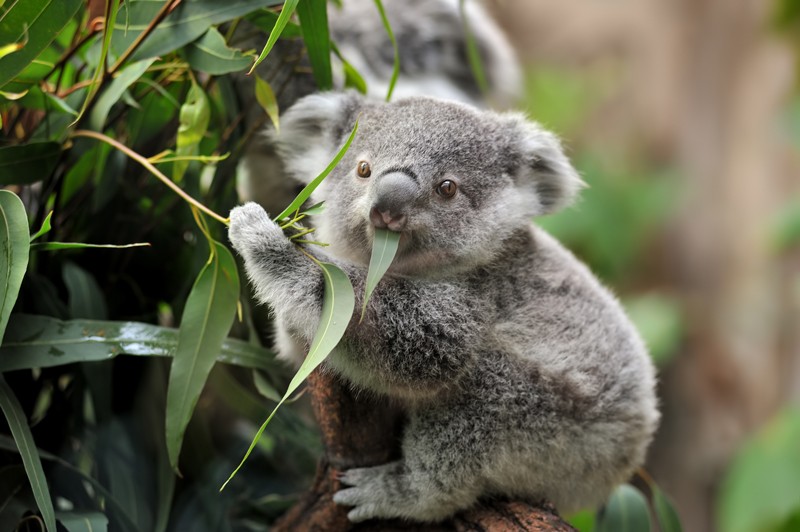(원문)
New gut bacteria can expand the diet of animals like koalas and rhinoceroses.
Koalas can be very picky about what kind of eucalyptus they eat.Credit: Getty
Koalas are among the world’s fussiest eaters, consuming only the leaves of eucalyptus trees — and just a few varieties of eucalyptus at that. Research now suggests that the animals’ discriminating diet is determined in part by the bacteria that live in their guts, which seem to restrict an individual koala’s ability to digest certain species of eucalyptus.
The finding, which was presented on 8 June at the annual meeting of the American Society for Microbiology (ASM) in Atlanta, Georgia, comes amid a growing interest in how an animal’s microbiome influences its ability to adapt to environmental change. Researchers studying koalas and other vulnerable species are trying to find out whether altering an animal’s gut bacteria through changes in diet— or even faecal transplants — can increase its chance of survival.
That is an urgent question for the koala (Phascolarctos cinereus), whose habitat in Australia is under threat from human activity. In some places, the koala population dwarfs the supply of eucalyptus — but even when the animals are transplanted to areas with abundant food, some die. Experiments by koala ecologist Ben Moore and his colleagues at Western Sydney University in Australia suggest that this might be due to an incompatibility between available eucalyptus varieties and the composition of an individual koala’s gut bacteria.
Moore and his colleagues collected faeces from 200 koalas at 20 sites around Australia. When the researchers analysed the plant materials in the faeces, they found that some koalas ate only a highly nutritious eucalyptus species known as manna gum (Eucalyptus viminalis). Others ate less-nutritious messmate (E. obliqua), and only a fraction of the animals would eat both — even at the same site. Two animals living 10 metres apart might have different food preferences.
When Moore and his colleagues analysed the microbial make-up of the faeces, they found that the koalas that preferred manna-gum eucalyptus harboured different bacteria from those that ate messmate. To test whether the different diets were the cause or the result of the different microbiomes, the researchers transplanted faeces from six wild koalas that ate messmate into six wild koalas that preferred manna gum. Within 18 days, the microbiomes of the koalas that underwent the procedure were nearly identical to those of the donor animals. Some of the animals that received transplants also seemed more willing to eat messmate.
To Moore, this suggests that koala-to-koala faecal transplants might help to expand the types of food available to individual animals and increase their chances of survival.
Eria Rebollar, a microbial ecologist at the National Autonomous University in Mexico City, says that the koala study is one of the first demonstrations that fecal transplants can affect the composition of wild animals’ microbiomes. Her own research, presented at the ASM meeting, has found that transplanting bacteria found on some frogs’ skin to other frogs can protect the recipients from deadly fungal infections.
Interspecies transplant
Other experiments suggest that some animals could benefit from having their microbiomes reshaped by faecal transplants from another species. A team led by Denise Dearing, a molecular biologist at the University of Utah in Salt Lake City, has found that desert woodrats (Neotoma lepida) — distant relatives of laboratory rats — carry gut bacteria that allow them to eat plants containing oxalate, a chemical that causes kidney stones. When the scientists, who work with Moore’s group, transplanted woodrat faeces into lab rats, the lab rats gained the ability to degrade oxalate1.
Other research suggests that protecting some endangered species might be as simple as changing their diet to accommodate the microbiome that is already there. At the ASM meeting, scientists from the San Diego Zoo in California presented findings that suggest how the gut microbiome of the near-threatened southern white rhinoceros (Ceratotherium simum simum) could interfere with its fertility. Captive-born southern white rhinos do not reproduce well.
The team from the San Diego Zoo compared the faeces of captive white rhinos with those of one-horned rhinos (Rhinoceros unicornis), which reproduce well in captivity. The white-rhino faeces contained chemicals known as phytoestrogens, which are present in plants such as soya and alfalfa and affect female reproductive hormones. Because both species of rhino ate the same diet, the researchers suspected2 that their gut microbes might break phytoestrogens down differently.
To test this, the zoo workers switched the female white rhinoceroses’ diet to grass pellets, which are low in phytoestrogens. Within two years, two females that had never successfully reproduced became pregnant; they went on to give birth to healthy calves. Candace Williams, a molecular biologist at the San Diego Zoo, says that the facility is now feeding grass pellets to all its rhinos — and researchers there are discussing their success with colleagues at other zoos.
Williams and her colleagues are now trying to identify which bacteria might be responsible for the shift, and comparing the microbiota of captive rhinos to those of wild rhinos in South Africa. “In zoo settings, people don’t think too much about microbes that live in these amazing animals,” Williams says.
That could change as DNA-sequencing technology continues to advance, and allows researchers to discover the composition of an animal’s microbiome more easily, Dearing says. She predicts that such tests will reveal many more instances of animals’ microbiota affecting their ability to survive in the wild. “I think it’s more common than we’ve been able to document,” she says. “In part we just didn’t have the tools to do this until recently.”
doi: 10.1038/d41586-018-05352-1
